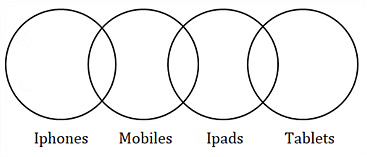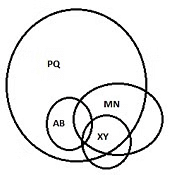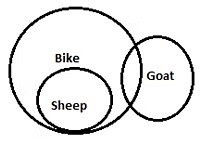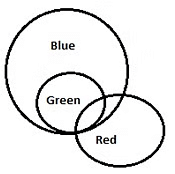Practice Questions: Syllogism- 1 | Logical Reasoning for CLAT PDF Download
What is Syllogism?
- The word syllogism is derived from the Greek word “syllogismos” which means “conclusion, inference”. Syllogisms are a logical argument of statements using deductive reasoning to arrive at a conclusion.
- The questions which are asked in this section contain two or more statements, and two or more conclusions follow these statements. One has to find out which of these conclusions logically follow the given statements. The statements have to be taken true even if they seem to be at variance from the commonly known facts.
- Syllogisms is an important topic in any competitive exam with a Reasoning section. Syllogisms is the quintessential technique to check one’s Logical Reasoning abilities, and to see if you can separate your Logical skills from your Verbal skills.
Syllogism Shortcut Tricks
Some steps to convert a solution into the possibility are given below:
- If All A are B, then it can be said – Some B are not A is a Possibility.
- If Some B are not A, then it can be said – All A are B is a possibility.
- If Some A are B, then it can be said – All A are B is a Possibility and All B are A is a Possibility.
- All Some <———> Not Reversed
- Some <———-> All
- NO Conclusion = Any Possibility is true
Solved Questions
Given beloware four statements:
Statement I: The main purpose of the visit is to develop a closer relationship among the two countries.
Statement II: The main purpose of the visit is to develop a closer relationship between the two countries.
Statement III: Between all the magazines on the shelves, only one was of my interest.
Statement IV: Among all the magazines on the shelves, only few were of my interests.
In light of the above statements, choose the correct answer from the options given below:
1. Statement I and Statement II are correct.
2. Statement I and Statement III are correct.
3. Statement II and Statement IV are correct.
4. Only Statement II is correct.
(a)1
(b)2
(c)3
(d)4
 View Answer
View Answer 
Ans: (d)
Sol: For statements (I) and (II), since only two countries are mentioned, "between" is the correct preposition.
Thus, sentence (II) is correct.
In statement (III), since there are a lot of magazines, "among" is the correct preposition to be used.
In statement (IV), the correct form of the second half is "only a few were of my interest".
Thus, only statement (II) is correct.
Hence, the answer is option D.
Q2: Given below are four statements:
Statement I: First we listened to the tape, then we answered some question, and at last we wrote the story.
Statement II: First we listened to the tape, then we answered some questions, and finally we wrote the story.
Statement III: We went from one restaurant to another, but all of them were full. At last we decided to buy some pizzas and take them home.
Statement IV: We went from one restaurant to another, but all of them were full. In the end we decided to buy some pizzas and take them home.
In light of the above statements, choose the correct answer from the options given below:
1. Statement I and Statement II are correct.
2. Statement I and Statement III are correct.
3. Statement II and Statement IV are correct.
4. Only Statement IV is correct.
(a)1
(b)2
(c)3
(d)4
 View Answer
View Answer 
Ans: (c)
Sol: In statement (I), since "some" is used as an adjective, the plural form of "question", i.e., "questions", should be used. Thus, it is incorrect. Statement (II) is grammatically correct and syntactically correct. Considering (III) and (IV), statement (IV) is a better choice as the use of "at the end" indicates the end of a process/activity. Thus, (II) and (IV) are correct. Hence, the answer is option C.
Q3: Given below are four statements:
Statement I: You must be pleased to hear that I’ve already got the tickets.
Statement II: You'll be pleased to hear that I’ve already got the tickets.
Statement III: I have friends who would love to stay at home, but they have to go to work.
Statement IV: I have friends who should love to stay at home, but they must go to work.
In light of the above statements, choose the correct answer from the options given below:
1. Statement I and Statement II are correct.
2. Statement II and Statement III are correct.
3. Statement II and Statement IV are correct.
4. Only Statement IV is correct.
(a)1
(b)2
(c)3
(d)4
 View Answer
View Answer 
Ans: (b)
Sol: Considering statements (I) and (II), since the speaker is informing about obtaining the tickets, the sentence should be in the future tense. Hence (II) is the correct sentence.
Considering statements (III) and (IV), "would" is the correct auxiliary verb to use as it shows a possibility, whereas should indicates an obligation, which does not suit the context of the sentence.
Thus, (II) and (III) are correct.
Hence, the answer is option B.
Q4: In the following question, two statements are given followed by four conclusions. Taking the given statements to be true, decide which of the given conclusions logically follows from the given statements:
Statements:
Some rivers are plateau.
No plateau is mountain.
Conclusions:
1. Some plateau are rivers.
2. Some mountains are rivers.
3. Some rivers are not mountains.
4. All mountains are rivers.
(a) Only I follows
(b) Both II and III follow
(c) Both I and III follow
(d) Both I and II follow
 View Answer
View Answer 
Ans: (c)
Sol: Since Some rivers are plateau, it definitely follows that Some plateau are rivers. Hence, conclusion I follows. This eliminates option 2. Now, No plateau is mountain. However, that does not mean that the sets of rivers and mountain have to intersect with each other. Hence, conclusions II and IV may or may not follow. This eliminates option 4. Now, any river that is a plateau cannot be a mountain (as No plateau is mountain). Hence, there are definitely some rivers that are not mountains i.e. conclusion III follows. Hence, option (c).
Q5: Choose the conclusion which logically follow from the given statement irrespective of commonly known facts.
Statement:
All branches are flowers.
All flowers are leaves
Conclusion :
I. All branches are leaves
II. All leaves are branches
III. All flowers are branches
IV. Some leaves are branches
(a) None follows
(b) Only I and IV follow
(c) Only II and III follow
(d) All follow
 View Answer
View Answer 
Ans: (b)
Sol: Since all branches are flowers, and all flowers are leaves, it implies that all branches are leaves and some leaves are branches. Hence, conclusions I and IV follow. Hence, option (b).
Q6: From the given statements, choose the conclusions which follow logically:
Statements:
i. Some iphones are mobiles
ii. Some mobiles are ipads
iii. Some ipads are tablets
Conclusions:
I. Some tablets are iphones
II. Some mobiles are tablets
III. Some ipads are iphones
IV. All iphones are tablets
(a) Only I & II follow
(b) Only I, II & III follow
(c) Only II & III follow
(d) None of these
 View Answer
View Answer 
Ans: (d)
Sol:
The statements i, ii and iii can be represented as shown above From the figure, Set of iphones do not intersect with the set of ipads and the set of tablets, and the set of mobiles do not intersect with the set of tablets. Consider the conclusions, From the figure, first three conclusions are not true. In this set, the fourth conclusion cannot be concluded. Hence, option (d).
Q7: In the question below, a statement is followed by three assumptions numbered I, II and III. An assumption is something supposed or taken for granted. You have to consider the statement and the following assumptions and decide which assumptions are implicit in the statement.It is believed by many economists that to realize a 7 percent GDP growth rate in India, which is very much attainable, the gross fixed capital formation in the country must increase to 30 percent of GDP from the present level of 28 percent.
I. The target of 7 percent GDP growth is not feasible.
II. GDP growth rate is directly related to capital formation rate.
III. The GDP growth rate in a country is the only indicator of country’s economic development.
(a) Both I and II
(b) Both II and III
(c) Both III and I
(d) None of A, B or C
 View Answer
View Answer 
Ans: (d)
Sol: Assumption I is not implicit, since it states that 7% GDP growth is not feasible while the passage mentions that it is “very much attainable”. Assumption II is implicit, since the passage does say that in order to attain a target GDP growth rate, there must be an increase in capital formation rate. Therefore, the two are directly related.
Assumption III is not implicit, since we cannot assume that there are no other indicators of a country's economic development besides the GDP growth rate. The passage provides no basis for such an assumption.
Since there is no option for 'Only II', we select option 4.
Hence, the correct answer is option 4.
Q8: All who studied commerce enjoy sports. No tax consultant enjoys sports. All those who enjoy sports love classical music.
If the above sentences are true, which of the following also must be true?
(a) No one who enjoys classical music is a tax consultant by profession.
(b) Every tax consultant enjoys classical music.
(c) No tax consultant enjoys classical music.
(d) No tax consultant studied commerce.
(e) No one who studied commerce enjoy classical music.
 View Answer
View Answer 
Ans: (d)
Sol: All those who studied commerce are incorporated in the sports category and no tax consultant enjoys sports. Thus, no tax consultant studied commerce.
Hence, the correct answer is option 4.
Q9: Statement 1: All chickens are birds.
Statement 2: Some chickens are hens.
Statement 3: Female birds lay eggs.
If the above statement are facts, then which of the following must also be a fact?
I. All birds lay eggs.
II. Hens are birds.
III. Some chickens are not hens.
(a) II only
(b) II and III only
(c) I, II and III
(d) None of the statement is a known fact
 View Answer
View Answer 
Ans: (d)
Sol: Statements I and II can be represented as venn diagrams in the following ways:
As ‘Female birds lay eggs’, so ‘All birds lay eggs’ is incorrect.Conclusion ‘Hens are Birds’ may or may not be true as can be seen from the Venn diagrams.
Conclusion ‘Some chickens are not hens’ is also not definitely true as can be seen from the third Venn diagram.
Hence, option (d).
Q10: Each of the questions below starts with a few statements, followed by four conclusions numbered 1, 2, 3 and 4. You have to consider every given statement as true, even if it does not conform to the accepted facts. Read the conclusions carefully and then decide which of the conclusion(s) logically follow(s) from the given statements, disregarding commonly known facts.
Statements:
a. All teachers are professors
b. All professors are researchers
c. All researchers are consultants
Conclusions:
1. Some consultants are teachers
2. All professors are consultants
3. Some researchers are teachers
4. All professors are teachers
(a) Only 1 and 2 follow
(b) Only 1 and 3 follow
(c) Either 1 or 4 follow
(d) None of the above
 View Answer
View Answer 
Ans: (d)
Sol: All teachers are professors.
This means that either the set of teachers is identical to the set of professors or the set of teachers is a subset of the set of professors.
All professors are researchers.
This means that either the set of researchers is identical to the set of professors or the set of professors is a subset of the set of researchers.
All researchers are consultants.
This means that either the set of researchers is identical to the set of consultants or the set of researchers is a subset of the set of consultants.
Let us analyze the conclusions now
1) Some consultants are teachers
This is true as the set of teachers will at least be a subset of professors which at least will be a subset of researchers which will at least be a subset of consultants.
2) All professors are consultants.
Set of professors will always be at least a subset of researchers which will always be at least a subset of consultants.
Hence this statement is also true.
3) Some researchers are teachers.
From the analysis of statement 1, we know that this statement is also true.
4) All professors are teachers. This is untrue because the set of professors is not a subset of teachers.
Directions (11-14): The following questions have a few statements followed by a conclusion. Read the statements and logically select the conclusions that can follow the statements.
Q11: Statements:
I. Some parrots are scissors.
II. Some scissors are not combs.
Conclusions:
I. Some scissors are parrots.
II. Some combs are parrots.
(a) Only I follows
(b) I and II but III follows
(c) II and I or III follows
(d) All of them follow
 View Answer
View Answer 
Ans: (a)
Sol: Some scissors are parrots (I to I), as the universal principal no. 4 says, that with two particular statements only I to I is possible. Therefore, only 1 conclusion is possible. Nothing else is possible.

Q12: Statement:
I. All AB are PQs
II. Some PQs are XYs
III. All XYs are MNs
Conclusions:
I. Some ABs are XYs
II. Some MNs are PQs
III. No AB is XY
IV. All PQs are ABs
(a) Only I follows
(b) I and II but III follows
(c) II and I or III follows
(d) All of them follow
 View Answer
View Answer 
Ans: (c)
Sol: 
From the venn diagram, we can see that Some MNs are PQs and Some ABs are XYs or No AB is XY by given statements.
Q13: Statements:
I. Some goats are sheeps.
II. All sheeps are bikes.
Conclusions:
I. All bikes are sheeps.
II. Some bikes are goats.
(a) Only I follows
(b) Only II follows
(c) Either I or II follows
(d) Both follow
 View Answer
View Answer 
Ans: (b)
Sol:
Q14: Statements:
I. All greens are blues
II. Some blues are reds
Conclusions:
I. Some blues are greens
II. All greens are reds
(a) Only I follows
(b) Only II follows
(c) Either I or II follows
(d) Neither follows
 View Answer
View Answer 
Ans: (a)
Sol: 
From the venn diagram, we can see that Some blues are greens is the only conclusion which follows the given statements.
Q15: Each of the questions below starts with a few statements, followed by four conclusions numbered 1, 2, 3 and 4. You have to consider every given statement as true, even if it does not conform to the accepted facts. Read the conclusions carefully and then decide which of the conclusion(s) logically follow(s) from the given statements, disregarding commonly known facts.
Statements:
a. Some boys are scholars
b. Some teachers are boys
c. All scholars are observers
Conclusions:
1. Some scholars are boys
2. Some scholars are not boys
3. Some observers are boys
4. Some teachers are scholars
(a) 1, and 3 follow
(b) 1, 3, and 4 follow
(c) Either 1 or 2 and 3 follow
(d) None of the above
 View Answer
View Answer 
Ans: (a)
Sol: Some boys are scholars: There are two possible deductions from this statement.
(i) All scholars are boys (i.e. the set of scholars is a subset of boys)
(ii) Some scholars are boys (i.e. the intersection of the sets of scholars and boys is not a null set)Some teachers are boysThere are two possible deductions from this statement.
(i) All boys are teachers (i.e. the set of boys is a subset of teachers)
(ii) Some boys are teachers (i.e. the intersection of the sets of teachers and boys is not a null set)All scholars are observers. There are two possible deductions from this statement.
(i) All observers are scholars (i.e. the set of observers and scholars are identical)
(ii) Some observers are scholars (i.e. the set of observers is a subset of scholars)Let us analyze the conclusions:
(1) Some scholars are boys. This is true for both the cases that have been mentioned above,
(2) Some scholars are not boys This may or may not be true because there are chances that all scholars may also be boys.
(3) Some observers are boys. We know that either all or some observers are scholars (i.e. the set of observers is definitely a subset of the set of scholars) and the intersection of the sets of scholars and boys is not a null set. This means that some observers will always be boys. Hence conclusion 3 is true.
(4) Some teachers are scholars. The intersection of set of boys and scholars is not a null set and the intersection of set of boys and teachers is not a null set. But this doesn’t mean that the intersection of boys and teachers will also be a null set. There may or may not be some teachers who are scholars.
Thus this statement is incorrect. Hence, option (a).
|
38 videos|144 docs|75 tests
|
FAQs on Practice Questions: Syllogism- 1 - Logical Reasoning for CLAT
| 1. What is a syllogism in logical reasoning? |  |
| 2. What are the basic components of a syllogism? |  |
| 3. How can I identify valid syllogisms? |  |
| 4. What are some common types of syllogisms? |  |
| 5. How can I improve my syllogism-solving skills for exams like CLAT? |  |





















